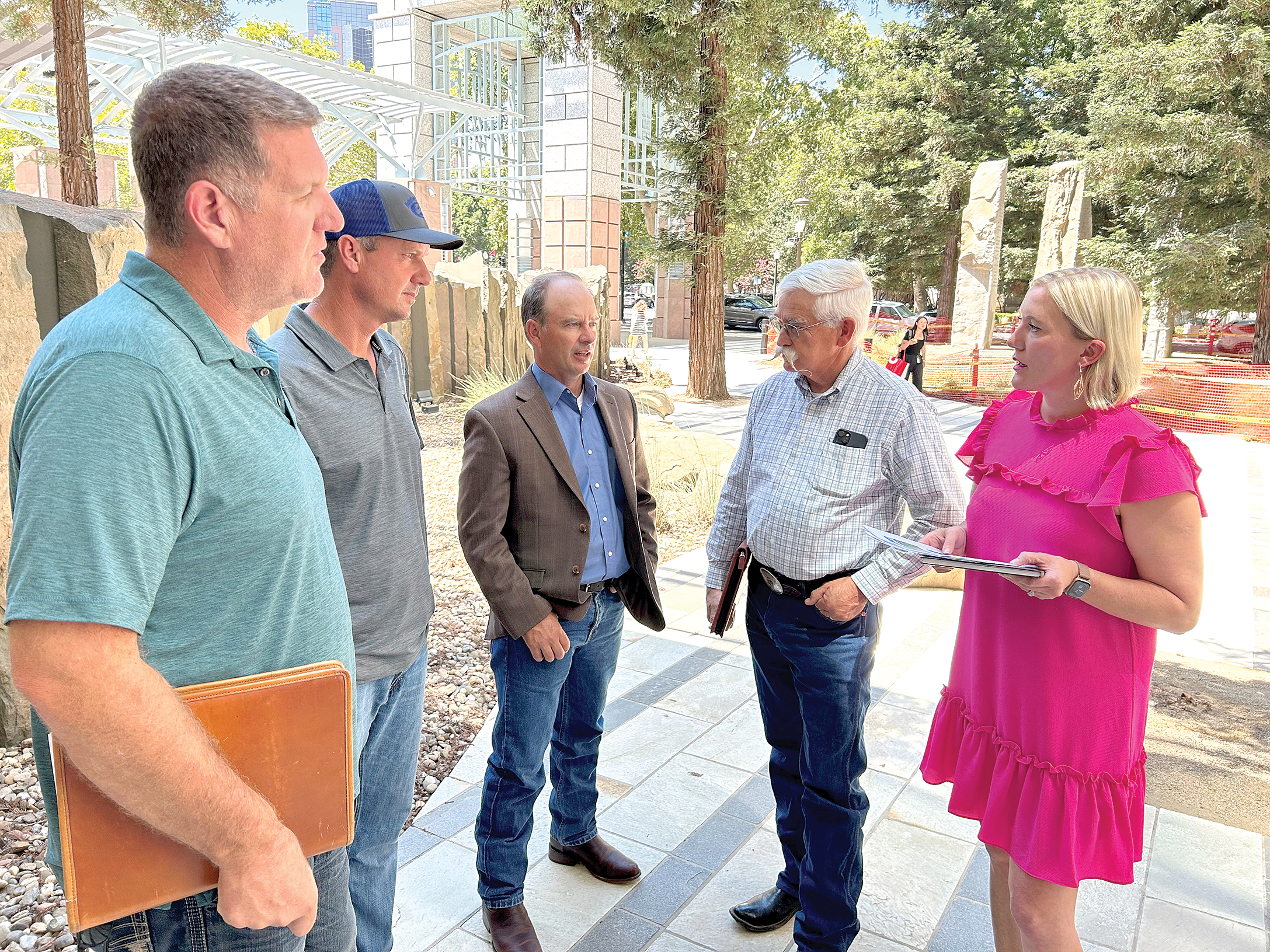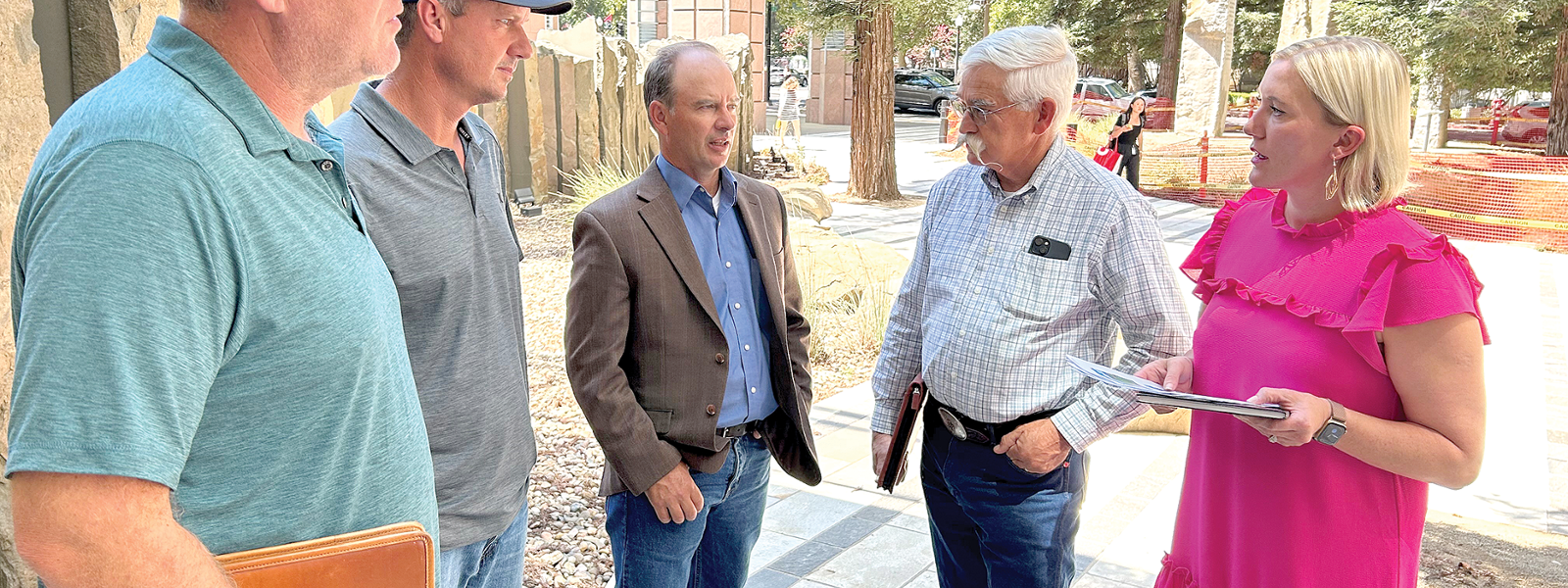Water board hits pause on flows for Scott, Shasta rivers

Siskiyou County farmers Brandon Fawaz and Jason Finley, from left, county Farm Bureau President Ryan Walker, California Farm Bureau field representative Ned Coe and senior policy advocate Alexandra Biering turn out for last week’s meeting of the California State Water Resources Control Board in Sacramento. The agricultural delegation called on the board to develop an alternative to permanent flows on the Scott and Shasta rivers.
Photo/Christine Souza

By Christine Souza
The California State Water Resources Control Board held off on a decision to set minimum instream flows on the Scott and Shasta rivers and instead directed staff to return next month with a plan to adopt interim flow measures to support salmon.
The board last week also asked farmers, tribes and other stakeholders to work together to develop plans for long-term restoration of the salmon fishery.
“We heard a lot of commonalities among the discussions we had,” said E. Joaquin Esquivel, chairman of the state water board, during a seven-hour session on the matter. “There is disagreement on how you get to where we want, but I know this community wants to see thriving agriculture, thriving fish and thriving tribes.
“This is a working board,” he added. “We are here to work with these issues and work with the communities that are impacted.”
Alexandra Biering, senior policy advocate for the California Farm Bureau, provided public comment, urging the board to not proceed with regulatory action. Instead, she called for allowing landowners and tribes to collaborate on better solutions.
Following the meeting, Biering said the board needed to leave some near-term protections in place but was not yet willing to initiate a process to set permanent instream flow requirements.
“This is not necessarily a win for any side but leaves open space for the parties to hammer out a long-term agreement for protecting fish, flows and the viability of the farming and ranching communities,” Biering said.
The agenda item was initiated by the Karuk Tribe’s July 1 petition, which requested the state water board use its emergency powers to curtail water use in these watersheds to prevent the extinction of coho salmon. The petition urged the board to set permanent minimum flows.
Karuk Chairman Russell “Buster” Attebery told board members that state law gives them the authority, and they have a duty to protect fishery resources.
Attebery said the tribe’s goal is not to drive farmers and ranchers out of business. But he added, “It is really hard to overstate how important the salmon are for the Karuk people. If these fish are driven to extinction, we will lose a part of who we are.”
“The Scott and Shasta (rivers) are the heartbeat of the Klamath’s salmon production, serving as key spawning grounds,” he said.
Siskiyou County Farm Bureau President Ryan Walker was part of an agricultural panel that spoke on behalf of the region’s farmers and ranchers. He said, “The emergency regulations are a way to make sure everyone stays at the table and keeps working towards a solution.
“I think the board would much rather have a proposal from stakeholders,” added Walker, a rancher from Montague. “There’s going to be extreme voices on both sides, but I think there’s a recognition that something that is more agreed upon would work better.”
The region’s farmers were affected by curtailment of their water rights since May 2021 when Gov. Gavin Newsom declared a drought emergency. The curtailment order for the Scott and Shasta rivers, which expired Aug. 1, limits surface-water diversions and groundwater pumping, and prioritizes minimum flows to protect threatened coho and other fish.
To put an end to “combat science,” Walker suggested a framework for interim measures that bridges the gap to a future where a science-based model advances restoration. He said it is important to collaborate with other stakeholders to develop data and science, flow models and hydrologic models that direct restoration and lead to improvements for fish.
“Agriculture can be part of the solution, but it’s not going to be the only solution,” Walker said. “We’ve got to look at what we can do to help chinook in-migration and develop scenarios that don’t penalize people that have done the conservation work, and most importantly, we need to work with our neighbors, agencies and tribes.”
Sari Sommarstrom, a retired watershed consultant in the Scott Valley community of Etna, said, “I’ve been working on trying to find that magical balance between fish and farms here for three decades.”
In discussing hypothetical models used by the California Department of Fish and Wildlife, Sommarstrom said, “We have real-world Scott River fish and flow data,” and suggested all parties collaborate and look at the true data for fish spawning.
“This is not dueling science. It is how we interpret that data, and the flows needed to be assessed instead of adopting a hypothetical that does not use local fish data, which we have,” Sommarstrom said. “The instream flow methodology is not intended for prescribing instream flow standards, yet it’s being promoted here as a regulatory tool.”
Fellow panelist Gary Black, a restoration and conservation consultant, farms along the Scott River. He said, “We are mindful and sympathetic, and we love a strong run of salmon. It’s our goal, too. We don’t like these droughts either and just have a difference of opinion on some of the metrics.”
Black agreed with board staff that more data about the condition of the watershed is needed.
“We should have better gauging data on all our tributaries,” he said. “That’s an area we can quickly jump on and improve.”
Siskiyou County farmer Brandon Fawaz of Etna informed the board of his investment in “countless irrigation upgrades” and how he cut back on alfalfa acreage to reduce water use.
Fawaz emphasized the need to tackle local water issues as a community.
“Tribes, communities and farmers—we all need water for fish, and trust us, no one wants that more than any of us,” Fawaz said. “Water flow without habitat won’t make fish, so I hope we can pause there and work on some things together.”
(Christine Souza is an assistant editor of Ag Alert. She may be contacted at csouza@cfbf.com.)




